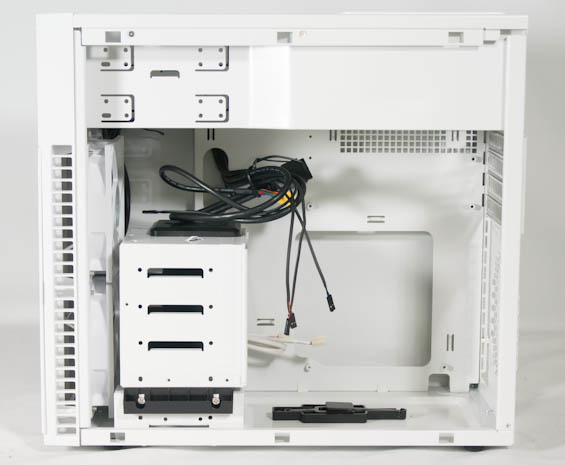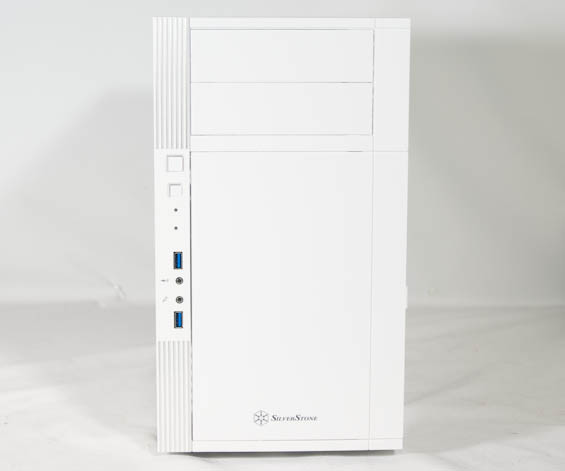SilverStone Precision PS07 Case Review Redux
by Dustin Sklavos on September 20, 2013 12:00 PM EST- Posted in
- Cases/Cooling/PSUs
- SilverStone
- MicroATX
_678x452.jpg)
During my tenure as case reviewer here, I've tried to avoid revisiting hardware whenever possible. There are a tremendous amount of cases available and more launching every day, so to go back and spend more time with something I've already tested is typically less fruitful for all involved. With that said, sometimes it's worth making an exception, and I absolutely believe the SilverStone Precision PS07 merits being checked out again.
The first time I reviewed the PS07 was more than a year and a half ago, when it launched. Yet what often happens with cases is that they see modest revisions during their lifespans. The manufacturers almost never publicize these revisions, but they're almost always positive. NZXT's initially much maligned H2 eventually had the door vent significantly widened to prevent it from suffering the same airflow issues our review unit did, and during the transition to USB 3.0, many manufacturers simply did a one-for-one swapped and replaced their USB 2.0 headers with USB 3.0. SilverStone is no different; the current PS07 is manufactured using thicker steel than the original, and SilverStone has replaced the middling fans they included in the original with quieter, more efficient models.

At the same time, there's been a bit of a dearth of strong Micro-ATX enclosures. Rosewill's Line-M is a good case, but not a great one; the Fractal Design Define Mini has acoustic padding but generally underperforms. The best Micro-ATX case I can really recommend at present is the Corsair Obsidian 350D, but that ignores SilverStone's entries from the year before. I was quite smitten with this enclosure design then, and our testing methodology has improved considerably since that time, so I'd like to see just how well it holds up.
One thing that hasn't changed is the assembly; rather than repeat myself, I'll simply direct you to the previous review so you can get a feel for it. This is essentially the design that the unfortunately overengineered Raven RV04 and Fortress FT04 are descended from, but the PS07 (and its fancier sibling, the Temjin TJ08-E) is a bit cleaner. It's still a SilverStone case, so assembly certainly isn't freshman level, but it's nowhere near the overcomplicated challenge the RV04 and FT04 are.

What I didn't see last time was the white model, and I found myself actually pretty smitten by it. The white paint job is going to be a little bit more prone to muss than the black one is, but it's at least distinctive, and overall it does a better job of blending together the plastic fascia with the steel body than the black one did. The two-toned stripes in the front are suited much better by the white in this reviewer's opinion.
| SilverStone Precision PS07 Specifications | ||
| Motherboard Form Factor | Mini-ITX, Micro-ATX | |
| Drive Bays | External | 2x 5.25" |
| Internal | 5x 3.5", 1x 2.5" | |
| Cooling | Front | 2x 120mm intake fan |
| Rear | 1x 120mm fan mount | |
| Top | - | |
| Side | - | |
| Bottom | - | |
| Expansion Slots | 4 | |
| I/O Port | 2x USB 3.0, 1x Headphone, 1x Mic | |
| Power Supply Size | ATX | |
| Clearances | HSF | 150mm |
| PSU | 160mm | |
| GPU | 330mm | |
| Dimensions |
15.75" x 8.27" x 14.73" 400mm x 210mm x 374mm |
|
| Special Features | Removable drive cage | |
| Price | $79 | |
The $80 price tag on the PS07 is competitive and puts it roughly in line with the other Micro-ATX cases. The $20 difference on the 350D and the Temjin TJ08-E is going to be worth considering, but I believe the comparative performance of the PS07 should also be a good indication of how well the overall superior TJ08-E will compete.


_thumb.jpg)
_thumb.jpg)
_thumb.jpg)
_thumb.jpg)
_thumb.jpg)
_thumb.jpg)
_thumb.jpg)
_thumb.jpg)
_thumb.jpg)
_thumb.jpg)
_thumb.jpg)
_thumb.jpg)








29 Comments
View All Comments
cragAT - Friday, September 20, 2013 - link
This is my current case. I only had two minor issues with the build. The first being the space available at the top of the case due to my wanting to install my secondary HDD in the 2nd drive bay (SSD is attached to the bottom of the case, makes for a very clean and cool interior, easy to overclock). The second issue was the lack of space behind the motherboard tray for extra PSU cording. I either need to upgrade to a SLI setup or switch to a Modular PSU for my next upgrade. I also love how the inside looks, black and red on white is a very pleasing color combination.themie - Friday, September 20, 2013 - link
alrighttrburnham - Friday, September 20, 2013 - link
I have the previous version of this case, and it is wonderful. Being able to fit a Micro ATX board in there is great, especially considering the case is relatively small. Even at full load, I barely hear any noise coming out of there. The only complaint I have is that cable management is a little tough in places (as seen in some of the photos in this article) and there is no windowed version.jabro - Friday, September 20, 2013 - link
Great follow-up! I know you don't like to revisit past reviews, but this mini-review shows that it can be worth while in certain circumstances.You mentioned two changes for the "new" PS-07, thicker steel and better fans. Do these changes apply to both the black and white PS-07 models? (I believe that there was a difference in fan quality between the white and black models)
Do you know if the TJ-08e is also being updated with a thicker steel design?
emilyhex - Friday, September 20, 2013 - link
Looks great, I like the white.just4U - Saturday, September 21, 2013 - link
me to.. I'd like to see one of the DVD/Blu-Ray makers come out with a White model though.. preferably like the old Panasonic slot loading (tray-less) models.bobbozzo - Sunday, September 22, 2013 - link
Even if you found a white drive, it probably would have a different finish (less glossy, ...)marc1000 - Friday, September 20, 2013 - link
I know that for testing purposes a big and hot GPU is more usefull thank any small one. but for any real-use scenario for people wanting a silent+small+fast system (in that order), installing one mid-range GPU from the current 28nm generations would be a lot better.just get any of them with a dual-fan open-air cooler and be happy, as this layout is FAR more silent than any blower-like cooler used in high-end GPUs. They also consume around 110W of power on average if you use vsync to limit the refresh rate (the 140~150W values are only on the most stressfull tests, something we do not do on the real-world for very long), so it will not throw too much heat in the chassis.
I have a pretty crowded Micro-ATX case, just installed a Zotac GTX660 (the smallest possible) and it seems to be dead-silent - but I believe that any Radeon7870 with dual fans would be as silent as this one. Of course there is some noise on the system, but it is absolutely easier on the ears than the sound of coolers from the past.
I know this doesn't apply to benchmarking, but I wanted to share some thoughts on micro-atx builds. I see no reasons to go full ATX other than "bragging rights".
DanNeely - Friday, September 20, 2013 - link
One of the GPUs used in testing was a GT 450 which is an ~ 100W midrange card. (For thermal testing being obsolete isn't a problem and maintaining hardware continuity in testing is valuable.)marc1000 - Saturday, September 21, 2013 - link
Good point, DanNeely! I was looking only at the gtx560 results! I believe the gt450 is really similar to gtx660 in thermal output! of course the performance delta is a world of difference, but I believe gpus with real-world draw around 100W are the perfect companions to micro-atx cases. and right now this class is really high-performing-midrange.http://anandtech.com/bench/product/609?vs=660